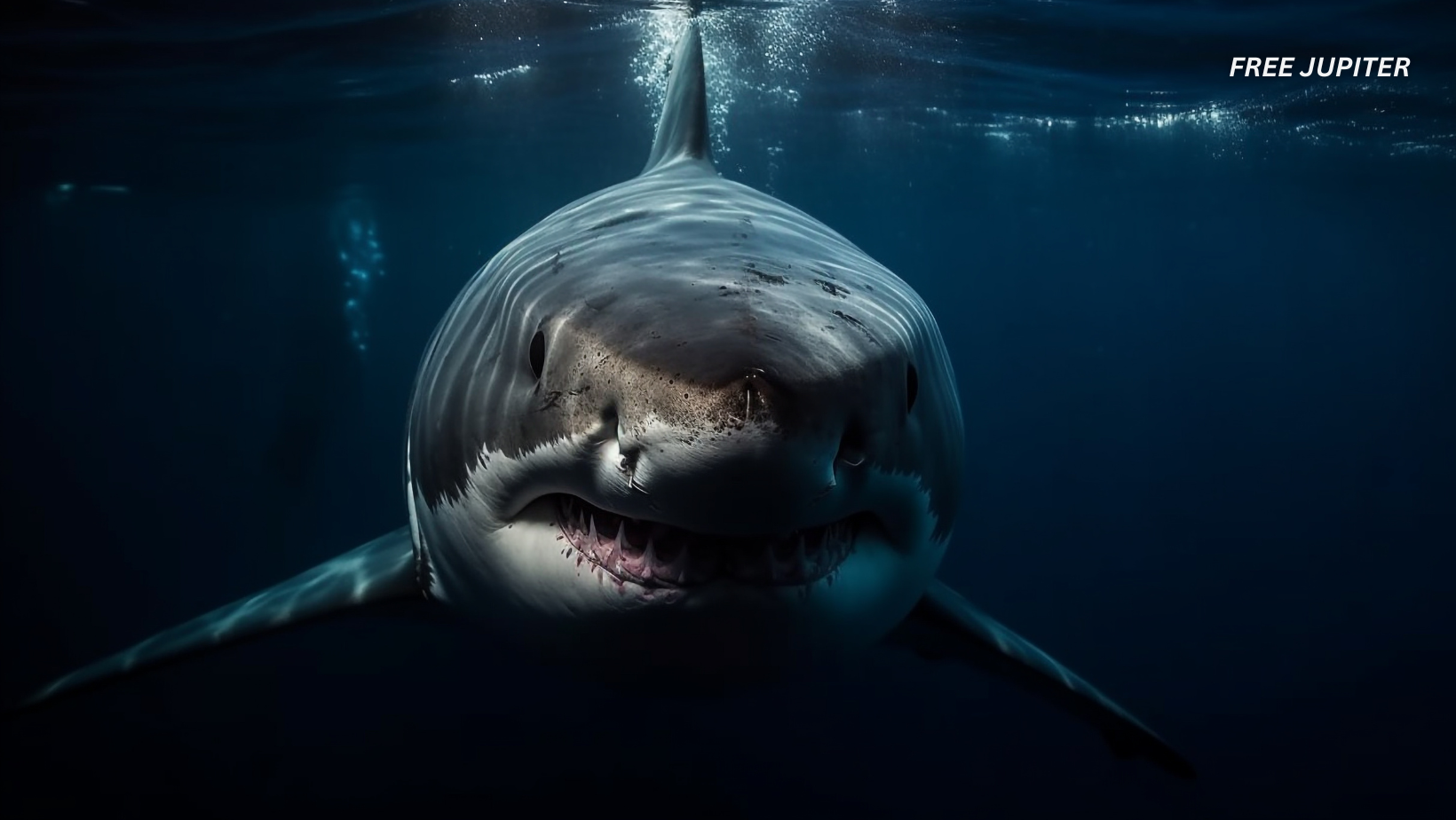Friendly Note: FreeJupiter.com shares general info for curious minds 🌟 Please fact-check all claims—and always check health matters with a professional 💙
Something big—really big—is gliding through the waters off the coast of North Carolina. And this ocean heavyweight has a name: Contender.
This isn’t just any shark. Contender holds the title of the largest adult male great white shark ever recorded in the Atlantic Ocean. At nearly 14 feet long and weighing over 1,600 pounds, he’s essentially a submarine with fins. Experts believe he’s about 32 years old, making him not only massive but also one of the more mature sharks currently being tracked in this part of the world.
The Tale of the Tag: Contender’s High-Tech Ocean Journey
Contender’s journey into the spotlight began in January, when researchers from the nonprofit organization Ocearch tagged him about 45 miles off the Florida-Georgia coastline. Ocearch is a group dedicated to studying large marine animals—especially apex predators like great white sharks—to better understand how they live, migrate, and survive in our changing oceans.
Equipped with a satellite tracker, Contender now sends location pings every time he surfaces. This device, expected to last around five years, gives scientists a detailed look into his travel patterns, surfacing behavior, and seasonal movement—data that was almost impossible to gather before technology like this existed.
Most recently, the tracker revealed Contender had surfaced roughly 22 miles off Cape Hatteras, a hot spot for marine life along North Carolina’s Outer Banks. His journey up the Atlantic coast has been a smooth one—starting from Florida and heading northward, just in time for the seasonal shift in ocean temperatures and prey availability.
Why Contender’s Movements Matter
Great white sharks are top predators, meaning they help keep ocean ecosystems in balance. But they’re also notoriously mysterious. Tracking individuals like Contender gives scientists clues about things like breeding habits, feeding zones, and even how climate change may be influencing where these animals go and when.
Before modern tagging, most of what we knew about shark behavior came from rare sightings or the occasional capture. Now, every ping tells a story. And with a shark as large and seasoned as Contender, researchers have a unique chance to study how adult males navigate the Atlantic across seasons.
According to marine biologists, sharks often migrate north during warmer months to seek out cooler waters and more abundant prey, such as fish and seals. North Carolina’s coast is essentially a buffet for traveling sharks, making it a natural pit stop for giants like Contender.
Read more:Scientists Discover Animals Have a Mysterious ‘Sixth Sense’, Changing Evolutionary Theories
What Sets Male Sharks Like Contender Apart?
While female great whites tend to grow larger overall—some exceeding 20 feet—male great whites rarely make it past the 13-foot mark. So, Contender’s size is extraordinary for his sex. His impressive length and weight help paint a broader picture of male shark development and longevity.
At 32 years old, Contender has likely seen more of the Atlantic than most fishing boats. The average life span of a great white is thought to be around 70 years, so he could be considered middle-aged. Studying older sharks like him could offer insight into aging, reproductive cycles, and how these creatures adapt over time.
Public Access: You Can Follow Contender’s Route Too
For ocean enthusiasts and curious minds, Ocearch offers a free global shark tracker available online and as a mobile app. The tracker lets anyone follow Contender and dozens of other sharks, sea turtles, and even whales in near real-time.
It’s not just cool—it’s educational. Watching how a single shark moves through thousands of miles of open ocean can change the way we think about marine life and the fragile web of ecosystems below the surface.
Read more: Man Falls 30 Feet Off Cliff in Hawaii Trying to Get a Better View of the Kilauea Volcano Eruption
Related Fin-Tastic Stories: Sharks in the Spotlight
Nukumi: The 17-Foot Matriarch of the Atlantic
Before Contender made waves, another great white shark captured the hearts and attention of scientists and shark lovers alike: Nukumi (pronounced noo-goo-mee), affectionately dubbed the “Queen of the North Atlantic.”
Measured at an astonishing 17 feet, 2 inches long, and weighing in at around 3,500 pounds, Nukumi is not just big—she’s monumental. She holds the title of one of the largest great white sharks ever tagged in the northwest Atlantic Ocean. To put her size in perspective, she’s about the length of a mid-sized bus, with a girth to match.
But Nukumi’s importance goes beyond size.
Scientists believe she was likely over 50 years old when they tagged her in October 2020 off the coast of Nova Scotia, Canada. This estimate makes her not only a biological marvel, but also a living record of decades’ worth of Atlantic ocean changes. Sharks like Nukumi, who live for so long, become floating archives of environmental shifts, feeding behavior, and reproductive patterns.
A Window Into Shark Motherhood
One of the biggest scientific takeaways from tagging Nukumi has to do with reproduction.
Because she was so large and mature, researchers suspect she had already given birth to many pups over the years. In fact, based on her size and age, she may have birthed dozens of offspring—each potentially around 4–5 feet long at birth. Female great whites don’t lay eggs; instead, they give birth to live young after an estimated 11-month gestation. It’s rare for scientists to get close to a shark at such a stage in her life, so Nukumi’s tagging was a unique opportunity to learn about how, when, and where older female great whites breed.
The hope is that the data collected from her satellite tracker—which pinged her location as she moved through different water temperatures and ecosystems—could help identify nursery zones and breeding hotspots. Protecting these areas could play a crucial role in the conservation of the species, especially since female great whites reproduce infrequently and have relatively few offspring compared to other fish.
Her Journey Through the Atlantic
After being tagged, Nukumi traveled more than 2,000 miles, making her way south from Canada through the U.S. East Coast, lingering at times in places like the Outer Banks and Florida’s coastal waters. These regions are believed to be rich feeding grounds—a kind of buffet line for large, mature sharks.
Her behavior confirmed what scientists had long suspected: that mature females follow specific, long-distance migratory routes tied to water temperatures, seasonal shifts, and prey availability. These paths, often referred to as “shark highways,” are now being mapped with greater accuracy thanks to tracking efforts involving sharks like Nukumi and Contender.
Read more: Under a Microscope, Grass Looks Like It’s Smiling When It Rains—And It’s Weirdly Adorable
Why Nukumi’s Legacy Matters
Nukumi’s name, chosen with guidance from the Mi’kmaq people, means “wise grandmother” in the Indigenous language—fitting for a creature that has lived through half a century of changing oceans. In many ways, she symbolizes not just the strength and mystery of great whites, but also the importance of long-term marine research.
By studying sharks like Nukumi, scientists are:
- Gaining insights into shark reproduction cycles
- Pinpointing critical habitats and migration patterns
- Understanding how climate change may alter marine predator behavior
- Building public awareness and empathy for a species often misunderstood
In the end, Contender is more than just a massive shark—he’s a living, swimming stream of insight, helping scientists unlock the secrets of one of the ocean’s most misunderstood and majestic predators. But he doesn’t swim alone in this mission. Contender follows in the wake of sharks like Nukumi, the legendary 17-foot matriarch who laid the scientific groundwork for this kind of long-term research. Together, their journeys are shaping how we understand shark survival, movement, and behavior in a changing world. Their legacies—etched in satellite data and ocean currents—are not only transforming science, but also deepening our connection to the mysterious, ancient life that still rules the deep.










